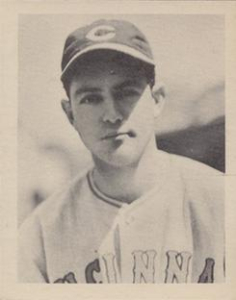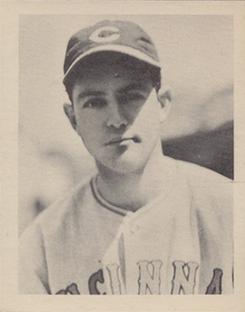May 9, 1938: Willard Hershberger stars as Reds pound Phillies
 To the extent that twenty-first-century baseball fans remember Willard Hershberger, they remember him for the unfortunate circumstances of his death. Hershberger, a 30-year-old backup catcher in his third season with the Cincinnati Reds, took his own life in a Boston hotel in August 1940 after a long struggle with depression. He was the first active major leaguer to die by suicide during a baseball season.
To the extent that twenty-first-century baseball fans remember Willard Hershberger, they remember him for the unfortunate circumstances of his death. Hershberger, a 30-year-old backup catcher in his third season with the Cincinnati Reds, took his own life in a Boston hotel in August 1940 after a long struggle with depression. He was the first active major leaguer to die by suicide during a baseball season.
Hershberger’s tragic story off the field tends to overshadow his accomplishments on it. He contributed to the Reds’ 1939 National League championship team and appeared in three games of that year’s World Series, won by the New York Yankees. He played a similar role for the Reds in 1940 as a trusted backup on a team that went on to win the World Series. Several teammates later said Hershberger had enough talent to start on another team, though he seemed content to back up Ernie Lombardi in Cincinnati.1
One of Hershberger’s brightest days on the field took place on May 9, 1938, when the Reds battled the Philadelphia Phillies in a Monday afternoon game at Crosley Field. Playing just his sixth major-league game, the rookie from California went 3-for-5 with four RBIs and a run scored, helping his team pull away to a comfortable 9-4 victory.
The Reds, a last-place team in 1937 with a woeful 56-98 record, were on the upswing in 1938 under new manager Bill McKechnie. Cincinnati entered the game with a 9-11 record, 7½ games back, in fourth place. The Reds ended the season still in fourth but boasted a much-improved 82-68 record; they finished just six games out of first, compared with 40 the season before.2 First baseman Frank McCormick led the NL with 209 hits in his first full season and finished fifth in Most Valuable Player voting.3 Lombardi hit .342 in 129 games, while right fielder Ival Goodman paced the Reds with 30 home runs.
On the mound, Paul Derringer (21-14) and Johnny Vander Meer (15-10) were Cincinnati’s big winners; Vander Meer etched his name into baseball history that June by pitching back-to-back no-hitters. The start on May 9, though, went to one of the less celebrated members of McKechnie’s staff. Righty Peaches Davis entered the game with a 1.63 ERA but a 1-3 won-lost record. Davis had shut out the Pirates in one of his four appearances but took close complete-game losses in two others. In his three previous starts, the Reds had scored only five runs. Davis ended the season with a 7-12 record in 29 games, including 19 starts.
While Hershberger was making his first major-league start behind the plate, he’d played most of the previous day’s game, replacing Lombardi in the second inning after Lombardi injured a finger. Hershberger collected two hits as the Phillies won, 2-0. Lombardi returned as the Reds’ starting catcher on May 11.
Manager Jimmie Wilson’s Phillies entered the May 9 game with a 4-13 record, in last place, 11 games back. The Phillies hadn’t finished a season above fourth place since 1917. The 1938 squad closed the year 45-105, becoming the first of five straight Phillies teams to lose more than 100 games.4 Probably the Phillies’ biggest victory of the year came in midseason, when the team abandoned run-down Baker Bowl and moved into Shibe Park as tenants of the Athletics.
Wilson gave the start to righty Claude Passeau, who’d been a workhorse the previous year, leading the NL in games started, innings pitched, and hits, runs, and earned runs surrendered. Passeau had made three prior appearances in 1938 and brought a 1-0 record and a 3.86 ERA into the game. Neither Davis nor Passeau had pitched against the other team thus far in the young season.
Philadelphia’s starting lineup included several players who went on to lead the team in offensive categories over the course of the season. These included center fielder Hersh Martin, the team’s eventual hit leader with 139; future Hall of Famer Chuck Klein in right field, Philly’s home-run leader with eight; and left fielder Morrie Arnovich, whose 72 RBIs paced Phillies hitters.
Only 673 fans turned out for the game—perhaps a reflection of the visiting team’s ineptitude, though news accounts blamed the weak attendance on cold, windy weather “entirely unsuited to baseball.”5 One Cincinnati paper said the Reds were sending a message: “The fact that the Cincinnati team staged the game was its way of letting the public know that it is the club’s policy to play as scheduled whenever possible.”6
The Phillies grabbed a 1-0 first-inning lead as second baseman Emmett Mueller drew a leadoff walk. After botching a bunt attempt and fouling off two pitches, Klein singled Mueller to third, and Martin’s double-play grounder scored Mueller.7 First baseman Earl Browne followed with a single but was caught in a pickoff play for the third out.8
Cincinnati rebounded in the second, with Hershberger in the middle of the action. Consecutive singles by McCormick, Hershberger, and center fielder Harry Craft brought in the Reds’ first run. After a sacrifice and an intentional walk, Davis hit a hard grounder that Phillies third baseman Pinky Whitney bobbled, allowing Hershberger to score.9 Second baseman Lonny Frey’s fly to left field scored Craft from third for a 3-1 Reds lead.
Cincinnati added another run in the third inning on a triple by Goodman and a fly out by Hershberger. The Reds added three more baserunners but could not score them. They had better luck in the fourth, when a pair of Phillies errors put the first two hitters on base.10 Hershberger’s double to right field scored two more runs to bring Cincinnati’s lead to 6-1. The Reds again stranded three baserunners. While some news coverage bemoaned their “bad habit” of leaving runners stranded “in clusters,” it did not come back to haunt them in this game.11
Righty reliever Pete Sivess came on to start the fifth inning for the Phillies, bringing an 8.74 ERA into the game. The Reds treated him just as rudely as they had Passeau. Pitcher Davis collected an infield hit and was sacrificed to second. One out later, McCormick singled in Davis and Hershberger singled in left fielder Dusty Cooke, who had walked. The Reds ran their lead to 9-1 in the seventh on a single by Goodman, outs by McCormick and Hershberger that moved Goodman to third, and a single to left by Craft.
Davis, meanwhile, had settled into a comfortable groove. The Phillies, who collected two hits in the first, mustered only one additional hit in the following seven innings; Arnovich’s double off the right-field screen with two out in the fifth.12 Davis retired 31-year-old rookie pinch-hitter Cap Clark to end the inning. Clark stayed in the game at catcher and managed a minor offensive contribution by drawing a walk in the eighth—the Phillies’ first free pass since Mueller walked to lead off the first.
Between and the second and the eighth innings, “lanky sinkerball expert” Davis was “complete master of the situation,” the Cincinnati Enquirer wrote.13 A cartoon accompanying the Enquirer’s game writeup taunted the visitors, noting that “[the] Phils looked like Dopey of the Seven Dwarfs in their futile attempts to knock off the Peach.”
The Phillies salvaged some small amount of honor in their last turn at bat. In the ninth inning they sent eight men to the plate, collecting three runs on four hits and a walk. Clark finally ended matters by grounding out to Cincinnati shortstop Billy Myers, wrapping up the game in 2 hours and 15 minutes. Davis earned a 9-4 complete-game win—“a dull victory,” in the judgment of the Philadelphia Inquirer—and Passeau took the loss.14
Another cartoon in the next day’s Cincinnati Enquirer honored Hershberger, Craft, and McCormick. The rookies had combined for eight hits and “entertained with some swell swing time,” the newspaper said. Hershberger went on to play 49 games that season and 160 in his three-season career, posting a lifetime batting line of .316/.356/.381.15
Acknowledgments
This article was fact-checked by Bruce Slutsky and copy-edited by Len Levin.
Sources and photo credit
In addition to the specific sources cited in the Notes, the author used the Baseball-Reference.com and Retrosheet.org websites for general player, team and season data and the box scores for this game.
https://www.baseball-reference.com/boxes/CIN/CIN193805090.shtml
https://www.retrosheet.org/boxesetc/1938/B05090CIN1938.htm
Image of 1939 Play Ball card #119 downloaded from the Trading Card Database.
Notes
1 For an in-depth look at Hershberger’s life and death, Charles F. Faber’s SABR Biography Project article on Hershberger is recommended. It is a primary source for the first two paragraphs of this article.
2 The Reds also played to a single tie in both 1937 and 1938.
3 McCormick hit just five home runs in 1938 but logged 106 RBIs.
4 The Phillies lost 100 games or more seven times between 1936 and 1945.
5 “Cincinnati Slams 14 Hits to Wallop Phillies, 9-4,” Philadelphia Inquirer, May 10, 1938: 19.
6 Tom Swope, “Bees and Cardinals Pounding at Heels of Cincy’s Team,” Cincinnati Post, May 10, 1938: 14.
7 “Cincinnati Slams 14 Hits to Wallop Phillies, 9-4.”
8 Browne played parts of four seasons in the majors but made most of his appearances in 1937, when he played in 105 of his 143 career games. Browne played in the majors for the final time on May 22, when he hit a pinch-hit double against the St. Louis Cardinals. Four days later the Phillies sold him to the Cardinals; he never returned to the big leagues.
9 Lou Smith, “Redleg Batters Have No Trouble Hitting Philly Pitchers,” Cincinnati Enquirer, May 10, 1938: 13.
10 In the Enquirer, Smith characterized the plays as “successive errors of easy bounders.” The erring Phillies were shortstop George Scharein and first baseman Browne. Philadelphia led the NL with 201 errors in 1938; the league average was 171.
11 Swope. Cincinnati stranded 14 runners, while Philadelphia stranded four. According to Swope, the Reds had stranded 89 runners in their previous 10 games.
12 Smith.
13 Smith.
14 “Cincinnati Slams 14 Hits to Wallop Phillies, 9-4.”
15 Hershberger collected 16 doubles, 5 triples, and no home runs, as well as 70 RBIs.
Additional Stats
Cincinnati Reds 9
Philadelphia Phillies 4
Crosley Field
Cincinnati, OH
Box Score + PBP:
Corrections? Additions?
If you can help us improve this game story, contact us.


